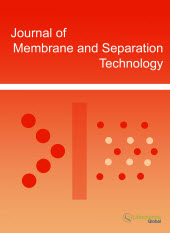jmst
Editor’s Choice : Preparation and Characterization of Superhydrophobic Modification of Polyvinylidene Fluoride Membrane by Dip-Coating
|
|
Abstract: The superhydrophobicity polyvinylidene fluoride (PVDF) membranes were modified via reducing surface energy by dip-coating perfluoroalkyl methacrylic copolymer (Zonyl 8740) onto the membranes prepared on mat glass. The chemical component of the unmodified and modified PVDF membranes surface was investigated by ATR-FTIR. Morphology and hydrophobicity of the unmodified and modified PVDF membranes were examined by scanning electronic microscopy and water contact angle, respectively. The effects of concentration of Zonyl 8740, coating time, conditions of heat treatment on hydrophobic capability of PVDF membranes were investigated. The results showed that the water contact angle increased from 141˚ to 151˚ by the dip-coating modification, therefore getting superhydrophobic PVDF membrane. Moreover, the porosity and the morphology of modified PVDF membrane were unchanged by the dip-coating modification. This results suggested that the hydrophobicty stability of the modified PVDF membrane was also good. Keywords: Polyvinylidene fluoride, Superhydrophobic, Coating modification, Perfluoroalkyl methacrylic copolymer, Membrane preparation. Download Full Article |
Editor’s Choice : Preparation and Performance of Catalytic Hollow Fibre Membranes for Hydrogenation Reduction of Nitrites in Water
|
|
Abstract: Porous Al2O3 hollow fiber membranes have been fabricated via a phase inversion – sintering technique. Pd-loaded carbon nanotubes(CNTs) are formed inside the hollow fibre wall by the catalytic decomposition of methane over Fe particles, followed by impregnation and reduction with hydrogen to form catalytic hollow fibre membranes. Hydrophobic modification of the hollow fibres is conducted by gas permeable polymeric coating. The resultant hollow fibre membranes exhibit highly catalytic activity to the hydrogenation reduction of nitrites in aqueous solution. Hollow fibre membrane reactors are assembled for nitrite hydrogenation by pumping nitrite solution into the tube side and introducing hydrogen countercurrently to the shell side of the reactor. The nitrite removal in the hollow fibre membrane reactors increases with the operation temperature and the hydrogen feed concentration at lower hydrogen partial pressures, but less influenced by the hydrogen feed concentration when it is higher than 50%. A higher nitrite concentration favors the nitrite hydrogenation reaction but lowers the nitrite removal efficiency. Keywords: Hollow fibre,catalytic membrane reactor,nitrite removal,hydrogenation reduction.Download Full Article |






















